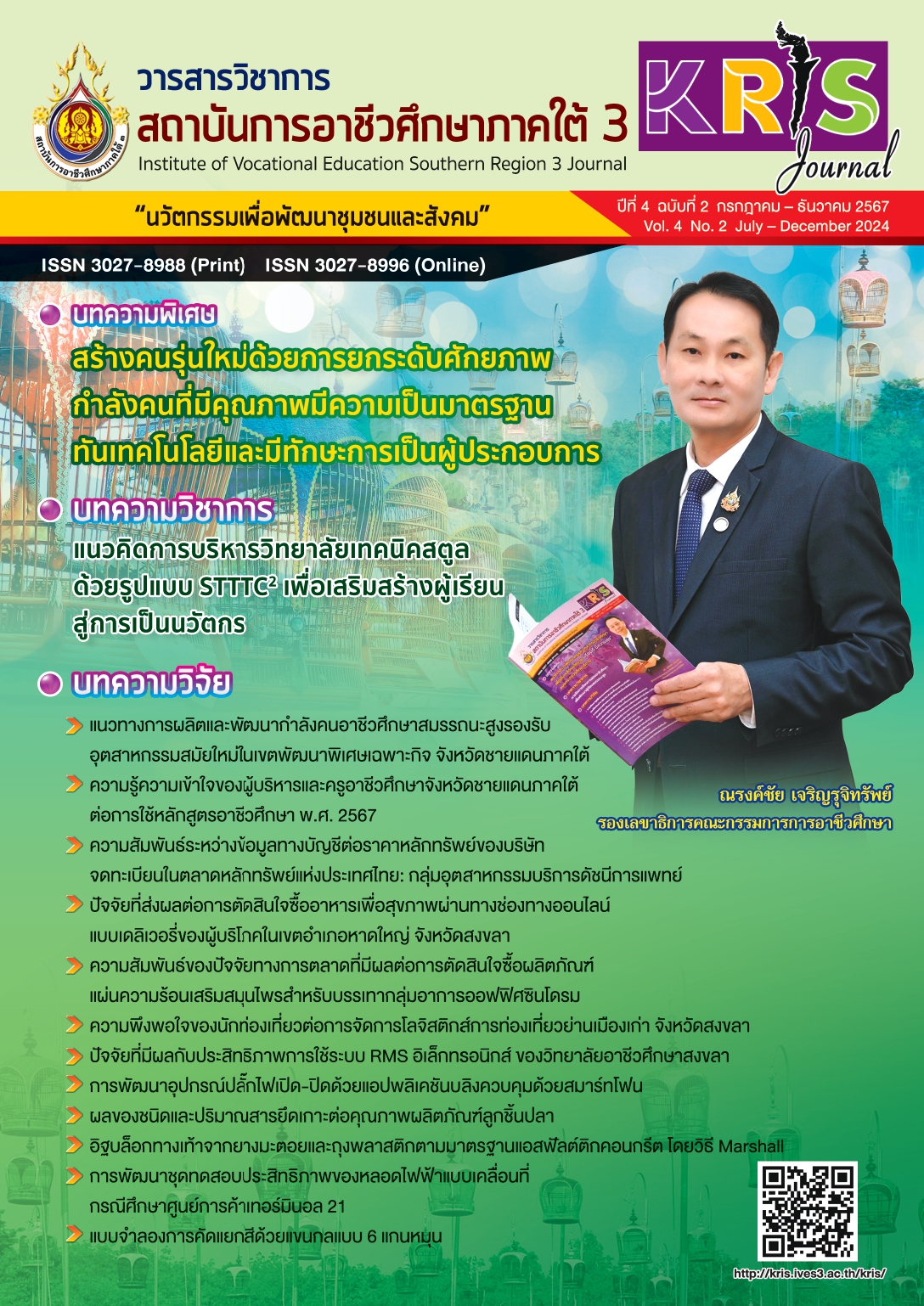Asphalt and Plastic Bag Pavement Blocks according to the Asphalt Concrete Standards by Marshall Method
Keywords:
pavement bricks, asphalt, plastic bagAbstract
The study on the ratio of asphalt and plastic bags affecting the quality of pavement blocks according to the asphalt concrete standard by Marshall method focused on finding the appropriate ratio for replacing 5% asphalt by using plastic bags in two ratios, i.e., 3:1 and 1:1 of 1,200 grams of aggregates consisting of different sizes of stone dust, i.e., 3/8” stone, 1/2" stone, 3/4” stone, and asphalt. After forming the pavement blocks based on the standard, they were then tested according to the Marshall method. It was found that the pavement blocks using both types of asphalt and plastic bag ratios had an effective asphalt volume of 5, a total specific gravity, a percentage of effective asphalt volume, and a value of air voids replaced by asphalt (voids filled with bitumen, V.F.B). The test showed that the pavement blocks with the ratio of 3:1 yielded higher values and were close to the standard while the ratio of 1:1 yielded lower values of air void and voids in mineral aggregates (V.M.A) and were closer to the standard. Thus, the study revealed that plastic bags can be used as mixtures without affecting the mechanical or physical properties of the materials.
References
กรมควบคุมมลพิษ. (2563). รายงานสถานการณ์มลพิษของประเทศไทย ปี 2562. กระทรวงทรัพยากรธรรมชาติและสิ่งแวดล้อม. https://www.pcd.go.th/publication/8013/
ประกาศกระทรวงอุตสาหกรรม ฉบับที่ 1462 (พ.ศ. 2531) ออกตามความในพระราชบัญญัติมาตรฐานผลิตภัณฑ์อุตสาหกรรม พ.ศ. 2511 เรื่อง กำหนดมาตรฐานผลิตภัณฑ์อุตสาหกรรมคอนกรีตบลอกประสานปูพื้น. (24 มีนาคม 2532). ราชกิจจานุเบกษา. เล่ม 106 ตอนที่ 46 หน้า 4.
เทอดเกียรติ ไชยลาภ. (2559). การศึกษาคุณสมบัติแอสฟัลต์คอนกรีตที่ใช้แอสฟัลต์ซีเมนต์ผสมยางพาราโดยใช้สัดส่วนยางพาราที่แตกต่างกัน [วิทยานิพนธ์ปริญญาวิศวกรรมศาสตรมหาบัณฑิต]. มหาวิทยาลัยเทคโนโลยีสุรนารี. http://sutir.sut.ac.th:8080/jspui/handle/123456789/7988
สำนักวิเคราะห์และตรวจสอบ. (2561). มาตรฐานงานทาง. กรมทางหลวง.
นิรชร นกแก้วและดำรงค์ ปำละกูล. (2017). สมบัติทางกายภาพของแอสฟัลต์คอนกรีตโดยวิธีมาร์แชลล์ที่อุณหภูมิต่าง ๆ. วารสารวิศวกรรมศาสตร์ มหาวิทยาลัยเชียงใหม่, 24(2), 128-138.
สำนักงานสภาพัฒนาการเศรษฐกิจและสังคมแห่งชาติ. (2564). แผนปฏิบัติการด้านการขับเคลื่อนการพัฒนาประเทศไทยด้วยโมเดลเศรษฐกิจ BCG พ.ศ. 2564-2570. https://www.bcg.in.th/bcg-action-plan/
คณุตม์ สมบูรณ์ปัญญา, ภูษิต บุญยฤทธิ์, วงศกร สิมมา และชิษณุพงศ์ สุธัมมะ. (2563). การศึกษาคุณสมบัติของคอนกรีตโดยใช้คอนกรีตผสมมวลรวมรีไซเคิลแบบย่อยซ้ำ. ใน การประชุมวิชาการวิศวกรรมโยธาแห่งชาติ ครั้งที่ 25 (หน้า 1213-1222).
ประสพโชค ชื่นศิริ, และนิรชร นกแก้ว. (2565). สมบัติทางวิศวกรรมของแอสฟัลต์คอนกรีตผสมขยะพลาสติกพอลิเอทิลีน. วารสารวิชาการพระจอมเกล้าพระนครเหนือ, 32(3), 724-734.
จุริพัตร บุญชุ่ม และวัชรินทร์ วิทยกุล. (2544). การศึกษาคุณสมบัติของโมดิฟายด์แอสฟัลต์คอนกรีตที่ผสมด้วยรีไซเคิลโพลิเอทีลีนชนิดความหนาแน่นต่ำ. วิศวกรรมสาร มก., 15(45), 146-154.
Downloads
Published
How to Cite
Issue
Section
License
Copyright (c) 2024 Institute of Vocational Education Southern Region 3 Journal (KRIS Journal)

This work is licensed under a Creative Commons Attribution-NonCommercial-NoDerivatives 4.0 International License.






